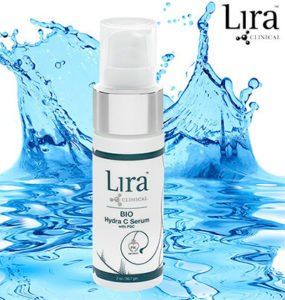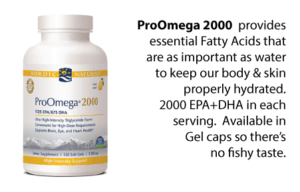Skin Hydration, Inside-Out & Outside-In
- By J.Maxine MacGwyre, LMA, Nutrition Specialist
- •
- 16 May, 2019
- •

By now, you have heard me say repeatedly that BEAUTYfull ® skin begins from within…as it relates to diet along the lines of “you are what you eat”. Hydration is a point of consideration with its own merit. Since the body does not manufacture water or essential fatty acids, both of which are required for the body, we could actually consider them the most important “supplements”. Dehydration compromises skin’s immune functioning as well as causing it to look older and more wrinkled. Skin tissue is constantly turning over, and depending on many factors, can be regenerated every 2-3 weeks. Targeted hydration, both dietary and topical, can dramatically increase the moisture level of the skin. There’s a “nourish from the inside-out and outside-in” story to be told here with skin hydration…so keep reading.
Skin Basics…from the outside
There are two ways to keep skin moist: (1) by stopping trans-epidermal water loss also known as TEWL, and (2) by adding moisture from the outside using topical skin care products which incorporate specific ingredients known to boost skin hydration.
The skin’s barrier, often referred to as the acid mantle, holds water and lipids in and keeps bacteria and environmental pollution out. A crucial part of the Acid Mantle’s success is its pH, with a typical range of 4.5 to 5.5; slightly acidic as reflected in the name. Skin with higher pH levels in the alkaline range tend to be dry and fragile. You may have concluded that it is important not to disrupt this pH balance, which can be compromised by using harsh soaps and over-the-counter products not formulated with this in mind.
Hydration from the Inside-out & outside-in
Here are some key nutrients that are known hydrators from both a dietary and topical perspective…
Vitamin C (Ascorbic Acid)
Most aestheticians consider topically applied vitamin C to be an essential driver in the synthesis of collagen, an antioxidant that helps to fight free radical damage in the skin, as well as naturally boosting the efficacy of SPF when used as part of your AM home care protocol. In addition to these important jobs, this vitamin contributes to skin hydration and elasticity.
While research is not clear on how vitamin C improves skin hydration, a higher intake of dietary vitamin C has been correlated with less dry skin, suggesting it may have effects on TEWL.

There are multiple formulations of vitamin C in skin care products. Professional products incorporate forms with more effective delivery methods driving them deeper into the skin. Ascorbic acid, the basic form of vitamin C, oxidizes quickly when exposed to air. Better choices include water-soluble ascorbyl palmitate and citric acid to ensure the vitamin C is delivered to skin without oxidizing and the Mac Daddy of forms being tetrahexyldecyl ascorbate (BV-OSC) a lipid formulation used in Lira Clinical products.
For delivery of vitamin C from the inside-out papaya, bell peppers, broccoli and strawberries are great sources.
Vitamin E
Vitamin E is a potent lipid-soluble antioxidant for skin hydration. It is an essential part of skin cell membranes and has a role in cellular communication and nutrient transportation. Topically applied vitamin E helps keep the skin healthy and soft.
Vitamin E exists in eight chemical forms with two main categories the tocopherols and tocotrienols, the latter being 40-60 times more effective at combatting free radicals.
Clearly, vitamin E plays an important role in maintaining the barrier function of our skin and appears to enhance the penetration and resorption of skin lipids, to help lock moisture in the skin and prevent dehydration.
Quality food sources for vitamin E are nuts, seeds and olive oil.
B Vitamins
The B vitamins are a complex and busy group but offer a wealth of benefits for our skin both internally and externally.
Niacin (B3) This B vitamin has three critical roles in the body: (1) converting glucose to energy, (2) aiding in the production of fatty acids and cholesterol, and (3) facilitating DNA repair.
As a player on the topical hydration team, niacinamide (its skin care form) increases the production of ceramides and fatty acids, two key components of our skin’s outer protective barrier. With a strong acid mantle, our skin is better able to keep moisture in and unwanted irritants out.
Dietary sources of vitamin B3 include tuna, chicken, turkey and peanuts.
Pantothenic Acid (B5) Vitamin B5 is a component of coenzyme A (CoA), an essential helper required for chemical reactions to convert the food we eat into energy. It also is involved in the synthesis of essential fats, cholesterol and steroid hormones such as estrogen and testosterone.

On the topical side, B5 facilitates hydration by maintaining the skin barrier function and by infusing water into the cells to retain moisture deep within the skin tissues.
In the diet, key sources of vitamin B5 include avocado, lentils, shiitake and crimini mushrooms.
Vitamin A (Retinol)
Vitamin A is a fat-soluble vitamin with many forms: retinol, retinal and the various retinol esters. Among other important functions, vitamin A supports cell growth and differentiation, which is how it may contribute to hydration in the skin.
In topical form, vitamin A improves hydration in and around skin cells in a few indirect ways, mostly by supporting healthy cell membrane functioning and encouraging skin cell turnover. In doing so, nutrient transport, waste removal and a reduction in TEWL result.
Several forms of topical vitamin A are used in skin care formulations. The main goal is to balance delivering an effective amount of vitamin A to the skin while managing the side effects that often accompany vitamin A application, primarily dryness and flaking. Many professional skin care manufacturers have incorporated technologies such as encapsulation to lessen the side effects while improving delivery. The least harsh, yet less effective forms are retinyl acetate, retinyl linoleate, retinyl palmitate and retinyl proprionate.
Dietary vitamin A comes from sweet potatoes, carrots, dark green leafy vegetables, dairy, fish and meat.
Essential Fatty Acids
Certain dietary fats, called essential fatty acids, are thusly named because the body cannot manufacture them and must therefore be consumed. These fats fall into two categories: omega 6 (O6) and omega 3 (O3).
The standard American diet (SAD) typically consists of too much O6 and too little O3. The recommended intake of O6 to O3 is a 2:1 ratio, yet the SAD diet sees closer to a 12:1 ratio. This imbalance leads to an inflammatory state. Additionally, a dietary deficiency in the balance of fatty acids results in a characteristic scaly skin disorder, increased epidermal turnover rate, weak capillaries, decreased wound healing, and increased TEWL leading to dry skin.
Topically, fatty acids are key players in skin hydration, but the best delivery vehicle is from the diet.

Dietary O6 fats come from vegetable oils such as palm, coconut and olive.
Omega 3. O3 fatty acids support the skin cell membranes of the epidermis, allowing for nutrient transport and removal of waste all at the cellular level. Although a good source of O3, fish oil is not a desirable ingredient in skin care due to its fishy smell and the heaviness of the oil. Preferred sources for topical skin care include algae and other marine plant sources.
Dietary O3 fats are found in fatty fish and fish oil, flaxseed and walnuts (in much lower levels). I strongly recommend supplementation with quality fish oils.
Lutein and Zeaxanthin
Many antioxidants and phytochemicals benefit the skin. Research has found that the daily consumption of 10 mg of lutein and 2 mg of zeaxanthin increases skin hydration, skin elasticity and superficial lipids. Dietary intake combined with topical application, improves hydration by 20%.
Lutein and zeaxanthin are micronutrients found in dark green, leafy vegetables like kale and spinach.
It Takes Two to Tango
Combining dietary and topical nutrition for skin health is especially important for skin hydration. This blog explored some of the most clinically significant players, but there are many other beneficial topical ingredients which will be explored further in Part 2 of Skin Hydration. In the meanwhile, remember that good clean eating will always lead to healthy, glowing skin.




